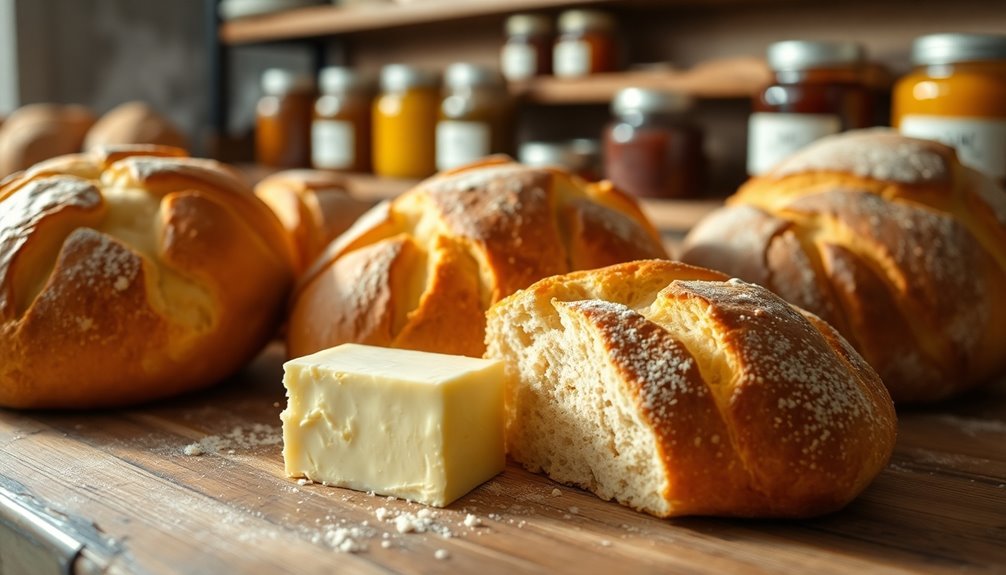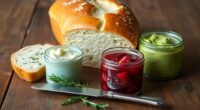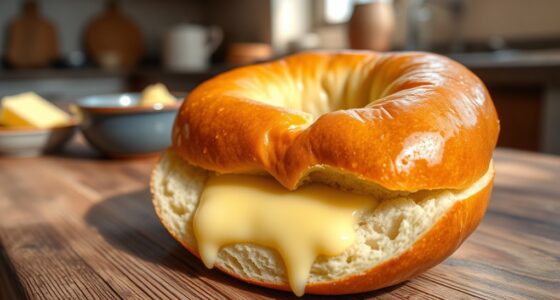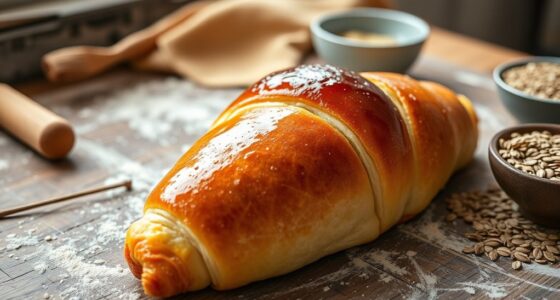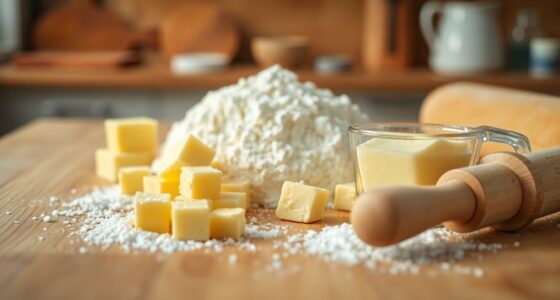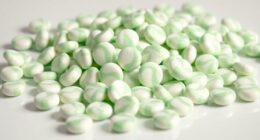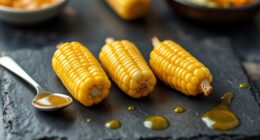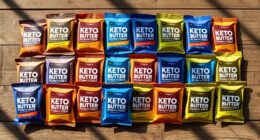In artisan bakeries, butter's crucial role enhances flavor and texture, shaping every creation. You'll find different types, like cultured and raw-milk butter, each offering unique taste profiles. Quality butter is essential for flaky pastries and moist breads, providing the rich, complex flavors you crave. Bakeries often utilize local and innovative butters for exceptional craftsmanship. As you explore, you'll discover even more about how butter influences artisan baking techniques and the evolving trends around this beloved ingredient.
Key Takeaways
- Butter enhances the flavor and texture of artisan baked goods, making it an essential ingredient in breads and pastries.
- Different butter types, like cultured and raw-milk butter, provide unique taste profiles that reflect regional influences.
- Quality butter is crucial for achieving flaky textures in laminated doughs, contributing to the overall success of pastries like croissants.
- Specialty butters infused with local ingredients allow bakers to experiment with innovative flavors, showcasing their creativity.
- The use of locally sourced butter supports sustainability and ethical farming practices within the artisan baking community.
The Role of Butter in Artisan Baking
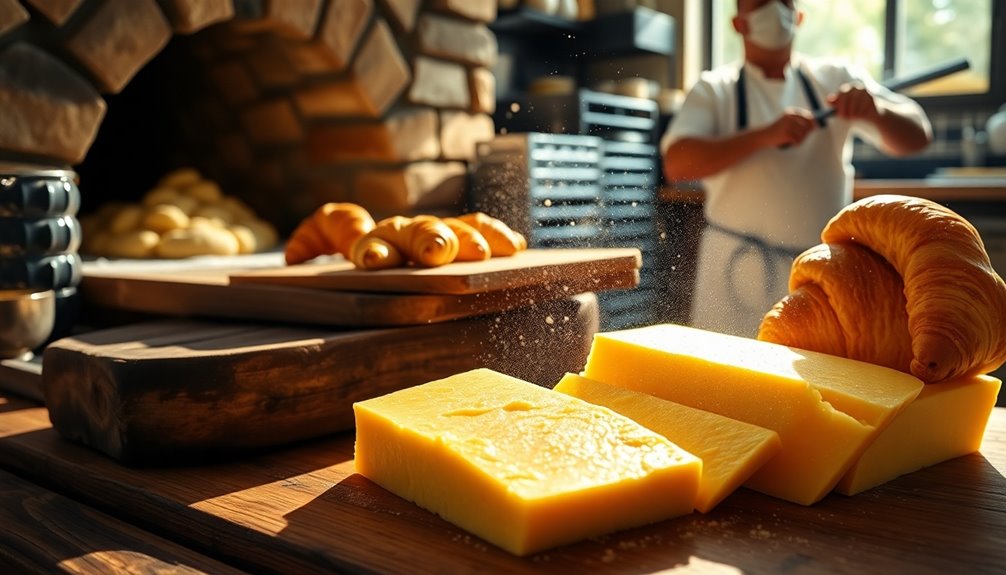
When you think about artisan baking, butter plays a crucial role in elevating your baked goods. Quality butter enhances the flavor and texture of artisan bread, making it more appealing.
As you explore your baking, consider using cultured butter for its tangy flavor, which can greatly improve your breads and pastries. Sourcing artisan butter from local dairies allows you to experiment with unique flavors that reflect your region's ingredients.
Different types, like sweet butter and raw-milk butter, bring distinct characteristics to your baked products. Plus, don't shy away from innovative combinations—think seaweed or spices—to further enhance your creativity.
Types of Butter Used by Artisan Bakeries
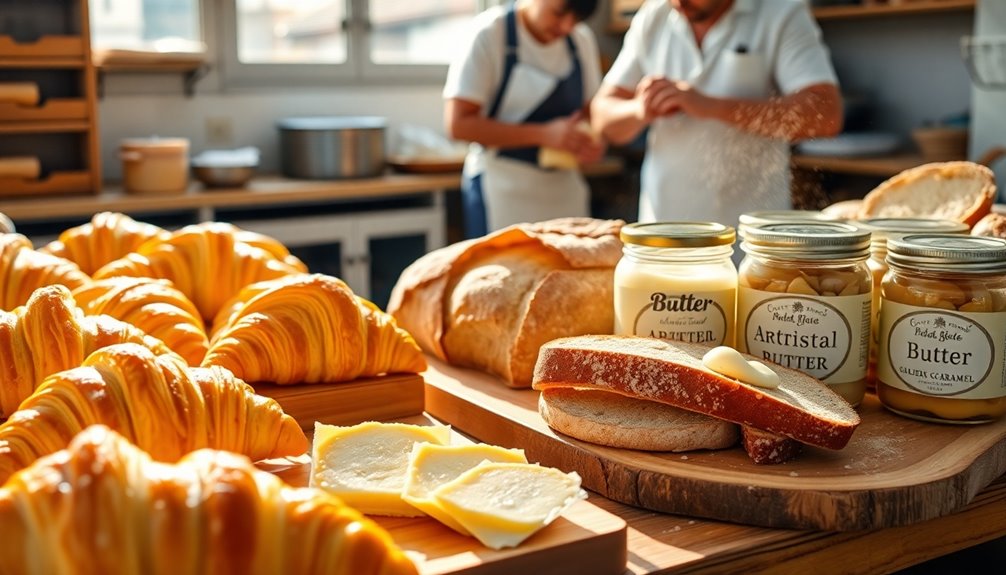
Butter varieties greatly influence the quality and flavor of artisan baked goods. Each type of butter brings a unique twist that bakers use to elevate their creations.
Here are some popular butter types you'll find in artisan bakeries:
- Cultured Butter: Tangy flavor enhances croissants and pastries.
- Raw-Milk Butter: Distinct tastes from the cows' varied diets impact breads and pastries.
- Sweet Butter: Gentle flavor, perfect for layering in laminated doughs like danishes.
- Innovative Butters: Options like seaweed butter add local flavors and unique twists.
Additionally, the use of butter sculptures in culinary arts showcases how bakers can push boundaries, transforming a simple ingredient into a work of art.
The Impact of Quality Butter on Flavor and Texture
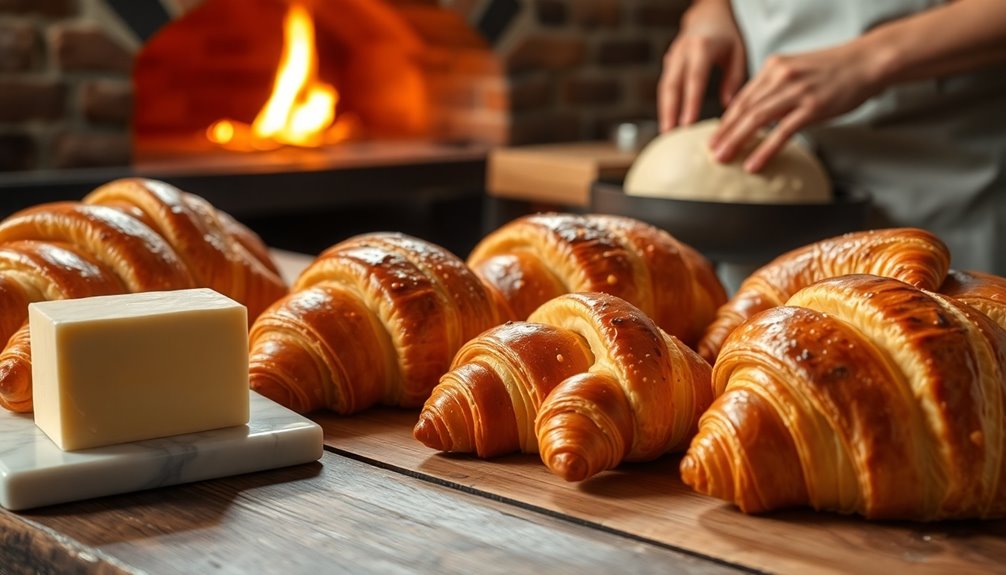
When you choose quality butter for your baking, you're revealing a world of flavor profiles and textures. Artisan butters can transform your pastries, adding richness and complexity that elevate every bite. Let's explore how different butters enhance culinary applications, making your baked goods truly stand out. Using cultured butter can add a delightful tanginess that enhances the overall flavor experience in your baked creations.
Flavor Profiles Explored
While exploring the world of artisan baking, you'll quickly discover that the quality of butter plays a pivotal role in shaping flavor profiles and textures.
High-fat cultured butters add richness, while raw-milk butter offers unique taste variations influenced by the cow's diet. Specialty butters can elevate your baking experience with unexpected flavors.
Consider the following:
- Richness: High-fat cultured butters create a deep, creamy flavor.
- Terroir: Raw-milk butter reflects the regional characteristics of the dairy.
- Innovation: Flavored butters, like seaweed or ham, introduce new dimensions.
- Mouthfeel: Quality butter enhances the overall eating experience.
Additionally, butter's saturated fat content can influence the health considerations of your baking choices.
Embracing these butter varieties can elevate your baked goods, making each bite a delightful exploration of flavor.
Texture Transformation Techniques
Quality butter dramatically transforms the texture of your baked goods, making them stand out in both flavor and mouthfeel. Using quality butter, like cultured or raw-milk varieties, enriches the crumb structure, creating a noticeably tender loaf or a flakier pastry.
Techniques such as lamination depend on the quality of butter to achieve that ideal flaky texture in croissants and Danish pastries. Additionally, specialized butters, including seaweed or chicken butter, introduce unique flavors while enhancing texture.
The fat content and freshness of butter play critical roles in the Maillard reaction, affecting not just color but also flavor development. Moreover, incorporating turmeric's anti-inflammatory properties into your diet can aid in recovery from any baking-related strain. In short, choosing the right butter elevates your baking, resulting in delightful textures that keep your customers coming back for more.
Culinary Applications Enhanced
Artisan bakers know that using high-quality butter can elevate the flavor and texture of their creations beyond the ordinary.
When you opt for premium butter, you can expect:
- Enhanced Flavor: Artisan and cultured butters provide rich, deep flavors that transform baked goods.
- Flaky Textures: In pastries like croissants, the water content creates steam, resulting in delightful layers.
- Innovative Additions: Specialty butters infused with seaweed or herbs add unique twists to traditional recipes.
- Improved Sensory Appeal: Richer butters contribute to a creamier mouthfeel and a more aromatic scent in artisan breads.
Innovative Uses of Butter in Baked Goods
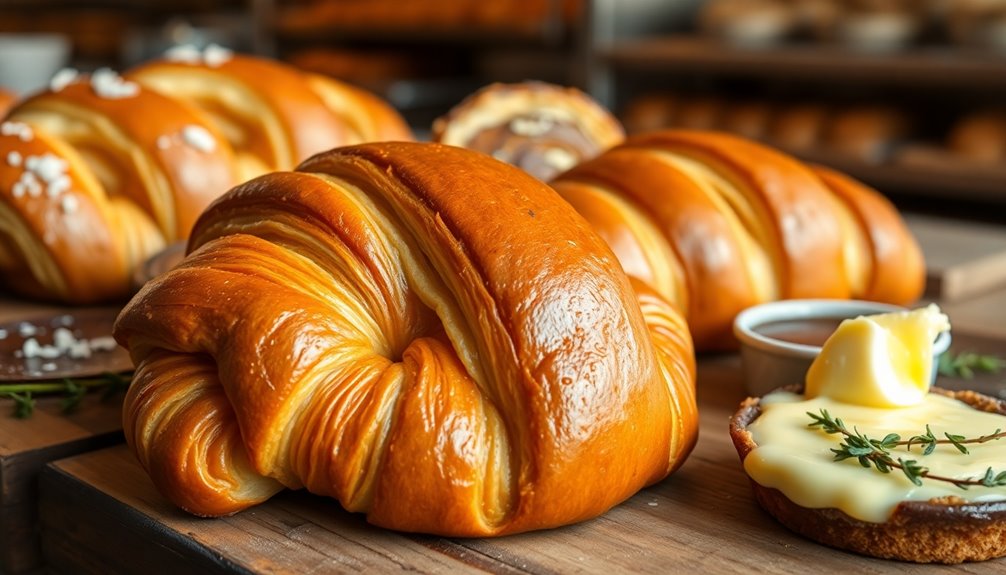
Innovative uses of butter are transforming the landscape of baked goods, inviting bakers to experiment with flavors and textures like never before.
Artisan bakeries are now embracing cultured butters, which enhance the flavor profile of breads and pastries through unique fermentation processes. Specialty butters, like those infused with seaweed or bold flavors such as Marmite and kimchi, add contemporary flair to baked creations.
The resurgence of artisan butter has ignited a focus on sourcing high-quality, locally produced options, ensuring they impact the final taste and texture of your favorite treats.
Plus, homemade butter-making techniques let you tailor flavors to complement specific baked goods, showcasing butter's versatility in everything from almond pastries to carrot cake creations. Continuous butter making allows for large-scale production of these innovative butters, ensuring consistency in quality and flavor.
Traditional Techniques in Butter Usage
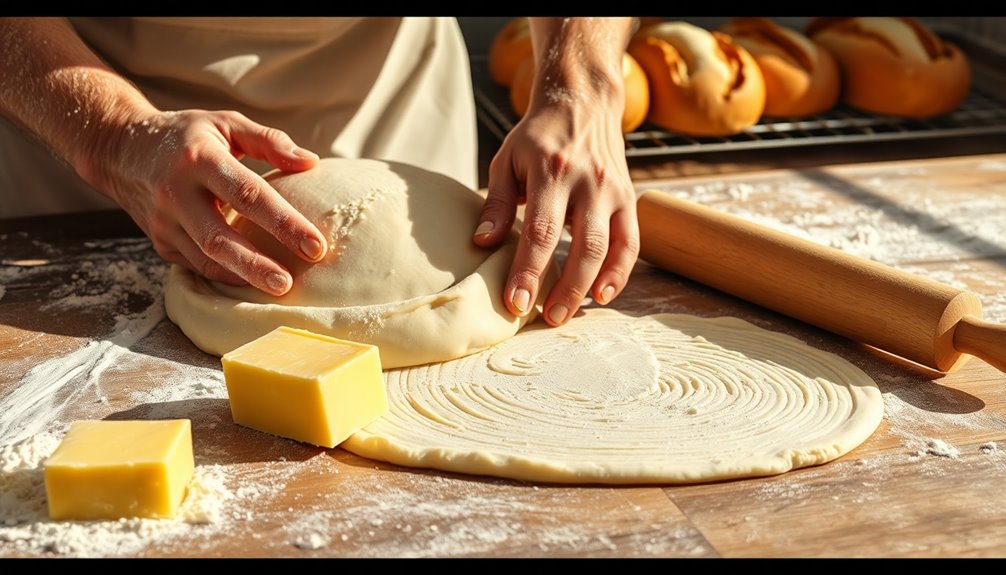
When you think about traditional techniques in butter usage, consider how essential butter is in the dough-making process.
By incorporating it at different stages, you can enhance the flavor and achieve the perfect texture in your baked goods.
This approach not only elevates your recipes but also showcases the unique qualities of high-quality butter. Additionally, using cultured butter can further deepen the flavor profile of your pastries, making them truly exceptional.
Butter's Role in Dough
Butter plays an essential role in dough, enhancing both flavor and texture in a variety of baked goods.
When you incorporate butter into your recipes, you'll notice significant differences, especially in pastries and enriched breads. Here are some key aspects of butter's impact on dough:
- Flavor: Different butter types, like cultured or sweet, can create unique taste profiles.
- Texture: Cold butter is crucial for achieving that perfect flaky texture in laminated doughs.
- Moisture: It adds richness, preventing dryness in your baked goods.
- Aeration: Techniques like the creaming method help aerate your dough, resulting in lighter cakes and cookies.
Using high-quality, locally sourced butter not only enhances these qualities but also supports sustainable baking practices. Additionally, choosing grass-fed butter can further improve the nutritional profile of your baked goods.
Flavor Enhancement Techniques
In artisan baking, enhancing flavor goes beyond just the ingredients you choose; it's also about how you use them. Cultured butter, made with heat-treated milk and starter cultures, can elevate your baked goods, adding unique taste experiences. Using quality artisan butter, like rich Irish butter, not only boosts flavor but also improves the appearance of your pastries and breads. Specialty butters infused with local ingredients or even seaweed butter offer exciting flavor combinations that modern palates crave. Additionally, herb-infused butter variations can transform savory baked items, providing an extra layer of flavor that complements the overall dish.
The Influence of Local Ingredients on Butter Selection
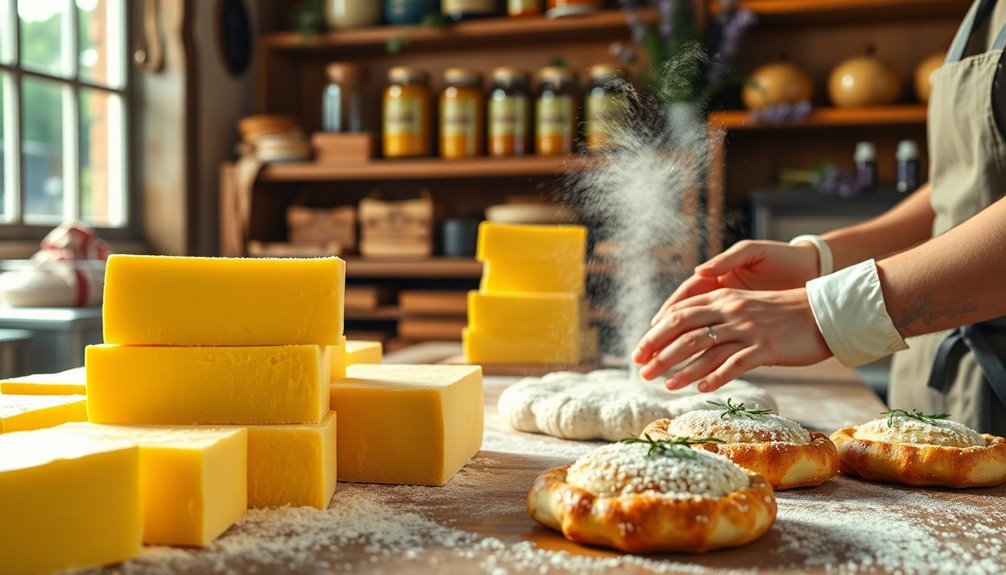
While the source of milk considerably shapes butter's quality and flavor, local ingredients take center stage in artisan butter selection.
By utilizing regionally sourced ingredients, artisan bakers create unique flavor profiles that reflect their locale. Here are some influences you might notice:
- Grass-fed Cows: The rich color of Irish butter showcases the impact of pasture conditions.
- Seasonal Sourcing: Artisan butter often avoids winter milk, promoting higher quality through seasonal ingredients.
- Fermentation Methods: Cultured butter, made from locally sourced milk, offers distinct regional flavors.
- Innovative Additions: Seaweed butter incorporates native sea vegetables, exemplifying geographic influences.
Embracing these local elements not only enhances artisan butter but also enriches the baking experience. Additionally, the choice of grass-fed cows can significantly influence the flavor and nutritional profile of the butter produced, as seen in various regions with a rich butter-making history.
Craftsmanship: How Butter Shapes Baking Practices
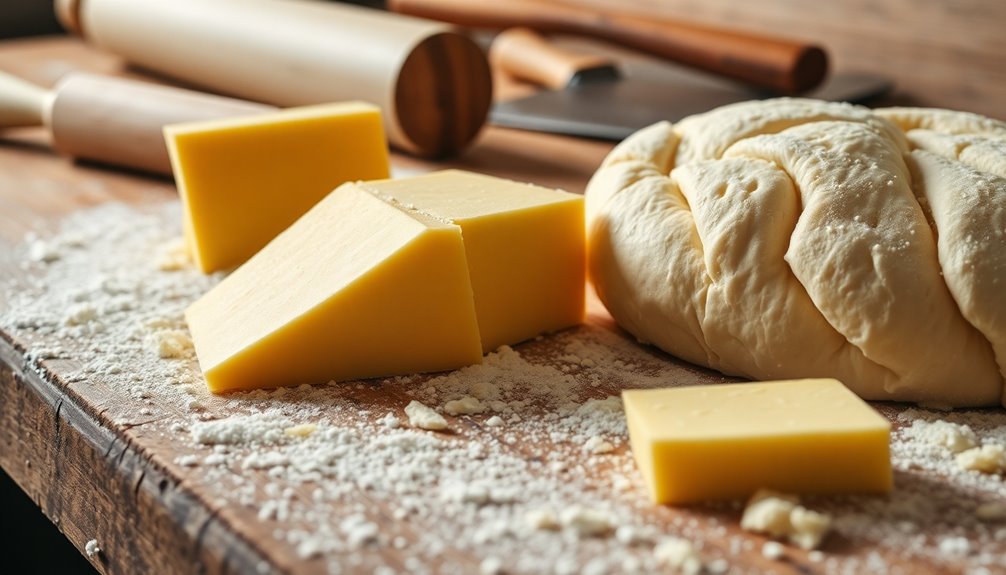
When you explore the world of artisan baking, you'll quickly notice how essential quality butter is to the craft. It enhances flavor and texture, making it a critical ingredient in any recipe.
The choice of butter—whether it's cultured or sourced locally—can dramatically affect your baked goods. For instance, using high-fat butter creates those flaky layers in pastries like croissants and danishes, allowing the dough to rise beautifully.
Artisan bakers also get creative, experimenting with unique butters infused with flavors like seaweed or kimchi. This trend not only supports local dairies but aligns perfectly with the artisanal approach, emphasizing quality ingredients and traditional methods. Moreover, understanding the nutritional composition of butter allows bakers to make informed choices that impact both flavor and health.
In the hands of skilled bakers, butter shapes the very essence of their craft.
Sustainability and Butter Sourcing in Artisan Bakeries
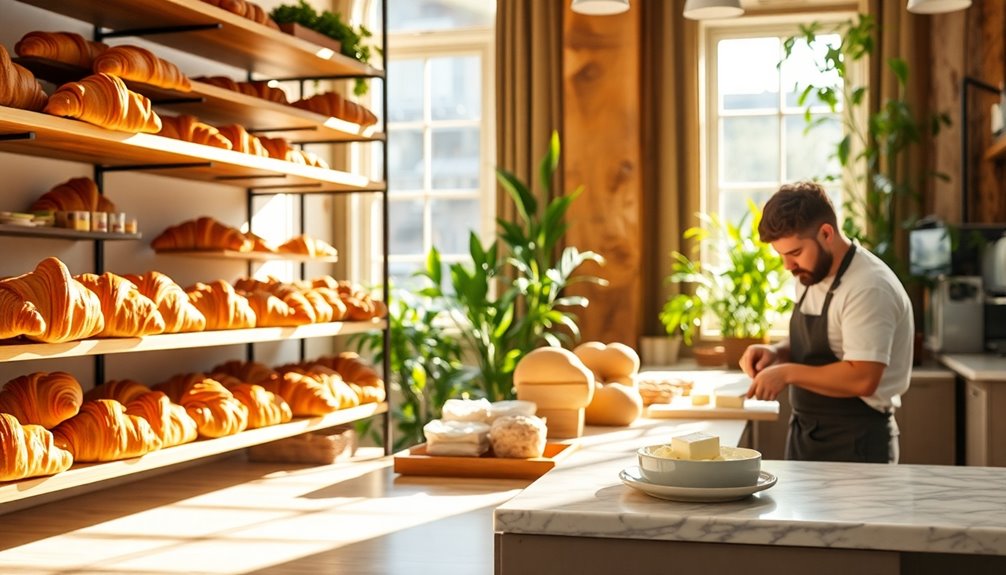
As artisan bakeries increasingly focus on sustainability, the sourcing of butter has become a vital aspect of their craft. By prioritizing high-quality, locally sourced butter, you not only enhance the flavor of your baked goods but also support local dairy farms and reduce food miles.
Here's how sustainability plays a vital role:
- Embracing ethical farming standards promotes animal welfare.
- Using cultured and raw-milk butters allows for unique flavor experimentation.
- Repurposing buttermilk byproducts minimizes waste in your bakery.
- Collaborating with local dairies fosters community relationships and transparency.
These practices not only elevate your offerings but also align with the growing consumer demand for quality ingredients, making your commitment to sustainability evident in every bite.
Celebrating Butter: A Key Ingredient in Artisan Bread and Pastries
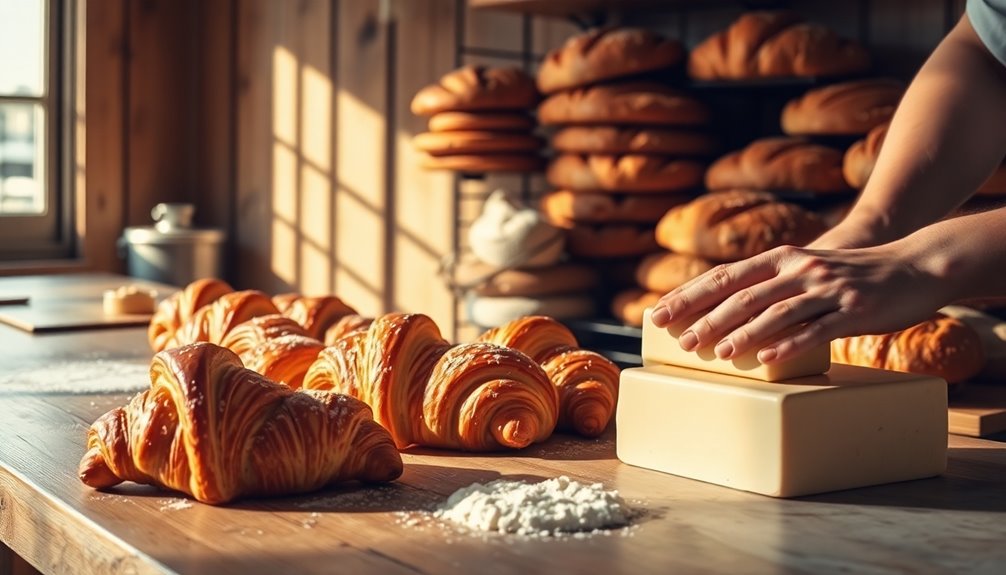
Butter isn't just an ingredient; it's the heart of artisan bread and pastries, transforming simple recipes into extraordinary creations. Quality butter, especially artisan or cultured varieties, enhances flavor and texture, making it vital to the baking process.
Traditional butter-making practices contribute to unique taste profiles, elevating your favorite baked goods. In laminated doughs, like croissants and Danish pastries, butter plays an essential role in achieving that flaky, airy texture you crave.
As you explore artisan bakeries, you'll notice a resurgence of interest in high-quality butter, reflecting a trend towards artisanal food products. Specialty butters infused with local ingredients offer creative expressions, allowing bakers to craft distinctive breads and pastries that celebrate the richness of this beloved ingredient.
Frequently Asked Questions
How Do You Shape Homemade Butter?
To shape homemade butter, start by beating 400ml of double cream until it separates into butter and buttermilk.
Don't overmix, as it can affect the texture.
Rinse the butter under cold water to get rid of excess buttermilk, which helps with flavor and shelf life.
Knead it gently to achieve a smooth consistency, adding salt or herbs for extra flavor.
Finally, store your shaped butter in an airtight container in the fridge.
What Is Artisan Butter?
Artisan butter's all about quality and flavor.
You'll find it's made from high-quality milk sourced from specific cow breeds, focusing on freshness rather than mass production.
Cultured butter offers a tangy taste that can elevate your dishes, while raw-milk butter brings unique flavors from unpasteurized milk.
When you see rich colors, like in Irish butter, it's often due to cows' diets, enhancing both the taste and appearance of your culinary creations.
Conclusion
In the world of artisan baking, butter isn't just an ingredient; it's the heart and soul of the craft. Did you know that using high-quality butter can enhance the flavor of bread by up to 30%? This statistic highlights how essential butter selection is in artisan bakeries. By understanding its role, you're not just enjoying a delicious treat, but also appreciating the craftsmanship that goes into every loaf and pastry. Celebrate butter—it truly makes a difference!
